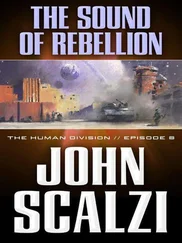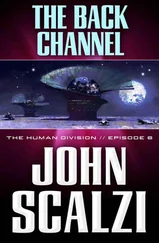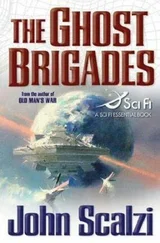“Is this going to start anytime soon?” asked Hester. “I thought we’d be done by now, and I kind of have to pee.”
Jenkins motioned to the toilet. “Be my guest,” he said.
“I’d rather not, ” Hester said.
“You can just tell us what you want us to know,” Dahl suggested. “We don’t have to have a slide show presentation.”
“Oh, but you do, ” Jenkins said. “If I just tell you, it’ll sound crazy. Graphs and images make it … well, less crazy, anyway.”
“Swell,” Finn said, and looked over at Dahl, as if to say Thanks for getting us into this . Dahl shrugged.
Another table pound by Jenkins, and the holographic image stabilized. “Ha!” Jenkins said. “Okay, I’m ready.”
“Thank God,” Hester said.
Jenkins fiddled his hands over the table, accessing a display of flat images parallel to the top of the display table. He found one he wanted and flipped it up into the view of the rest of them.
“This is the Intrepid, ” Jenkins said, motioning to the rotating graphic that now hovered atop the holographic table. “The flagship of the Universal Union Space Fleet, and one of the fleet’s largest ships. But for all that, one of just thousands of ships in the fleet. For the first nine years of its existence, aside from being appointed the flagship, there was nothing particularly special about it, from a statistical point of view.”
The Intrepid shrank and was replaced by a graph showing two closely conforming lines plotted across time, one representing the ship, the other representing the fleet as a whole.
“It had a general mission of exploration and from time to time engaged in military actions, and in both scenarios suffered crew losses consistent with Dub U average, if slightly lower, because the Dub U sees the flagship as a symbol, and generally gave it less strenuous missions. But then, five years ago, this.”
The graph scrolled to include the last five years. The Intrepid ’s line spiked violently and then plateaued at a substantially higher level than the rest of the fleet.
“Whoa,” Hanson said.
“‘Whoa’ is right,” Jenkins said.
“What happened?” Dahl asked.
“Captain Abernathy is what happened,” Duvall said. “He took command of the Intrepid five years ago.”
“Close but wrong,” Jenkins said, and waved his hands over the table, rooting through visual elements to find the one he wanted. “Abernathy did take command of the Intrepid five years ago. Before that he was captain of the Griffin for four years, where he developed a reputation of being an unconventional and risk-taking but effective leader.”
“‘Risk-taking’ could be a euphemism for ‘getting crew killed,’” Hester said.
“Could be but isn’t,” Jenkins said, and threw an image of a battle cruiser into the view. “Here’s the Griffin, ” he said. A graph scrolled out behind it, like the one that scrolled out behind the Intrepid earlier. “And as you can see, despite Abernathy’s ‘risk-taking’ reputation, the crew fatality rate is on average no worse than any other ship in the line. That’s impressive considering the Griffin is a battle cruiser—a Dub U warship. It’s not until Abernathy gets to the Intrepid that fatalities for crew under his command spike so massively.”
“Maybe he’s gone nuts,” Finn said.
“His psychological reviews for the last five years are clean,” Jenkins said.
“How do you know—” Finn stopped and held up his hand. “You know, never mind. Dumb question.”
“He’s not insane and he’s not purposefully putting his crew at risk, is what you’re saying,” Dahl said. “But I remember Lieutenant Collins saying to me that when people complained about the high crew death rate on the Intrepid, they were told that as the flagship it engaged in riskier missions.” He pointed at the screen. “You’re telling us that it’s not true.”
“It’s true that away missions result in higher deaths now,” Jenkins said. “But it’s not because the missions themselves are inherently more risky.” He fiddled and threw several ship images up on the screen. “These are some of our combat and infiltration ships,” he said. “They routinely take on high-risk missions. Here are their average crew fatalities over time.” Graphs spewed out behind their images. “You can see their fatalities are higher than the Dub U baseline. But”—Jenkins dragged over the image of the Intrepid —“their crew fatalities are still substantially lower than the Intrepid ’s, whose missions are generally classified as having far less risk.”
“So why do people keep dying?” Duvall asked.
“The missions themselves are generally not risky,” Jenkins said. “It’s just that something always goes wrong on them.”
“So it’s a competence issue,” Dahl said.
Jenkins tossed up a scrolling image featuring the Intrepid ’s officers and section heads and their various citations and awards. “This is the flagship of the Dub U,” he said. “You don’t get to be on it if you’re an incompetent.”
“Then it’s bad luck,” Finn said. “The Intrepid has the worst karma in the known universe.”
“That second part might be true,” Jenkins said. “But I don’t think luck has anything to do with it.”
Dahl blinked and remembered saying the same thing, after he dragged Kerensky into the shuttle. “There’s something going on with the officers here,” he said.
“Five of them, yes,” Jenkins said. “Abernathy, Q’eeng, Kerensky, West and Hartnell. Statistically speaking there’s something highly aberrant about them. When they’re on an away mission, the chance of the mission experiencing a critical failure increases. When two or more of them are on the same away mission, the chance of a critical failure increases exponentially. If three or more are on the mission, it’s almost certain someone is going to die.”
“But never any of them, ” Hanson said.
“That’s right,” Jenkins said. “Sure, Kerensky gets the shit kicked out of him on a regular basis. Even the other four are occasionally knocked around. But death? Not for them. Never for them.”
“And none of this is normal,” Dahl prompted.
“Of course not!” Jenkins said. He flipped up pictures of the five officers, with graphs behind them. “Each of them has experienced exponentially higher fatality rates on away missions than any other officers in the same positions on other ships. That’s across the entire fleet, and across the entire existence of the fleet, back to the formation of the Dub U nearly two hundred years ago. You have to go back to the blue water fleets for the same types of fatalities, and even the officers themselves didn’t escape mortality. Captains and senior officers were dropping dead all the time.”
“That’s what scurvy and plague will do,” Hester said.
“It’s not just scurvy, ” Jenkins said, and waved at the officers’ pictures. “Officers die today too, you know. Having rank changes mortality patterns somewhat but doesn’t eliminate them. Statistically speaking, all five of these guys should be dead two or three times over. Maybe one or two of them would have survived all the experiences they’ve had so far. But all five of them? The odds are better that one of them would get struck by lightning.”
“Which they would survive,” Finn said.
“But not the crewman next to him,” Duvall said.
“Now you’re getting it,” Jenkins said.
“So what you’re saying is all this is impossible,” Dahl said.
Читать дальше











